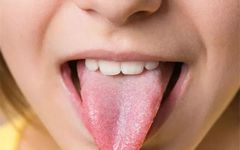Comprehensive Guide to 22 Types of Tongue Diagnosis: Understand Your Body Through Your Tongue.
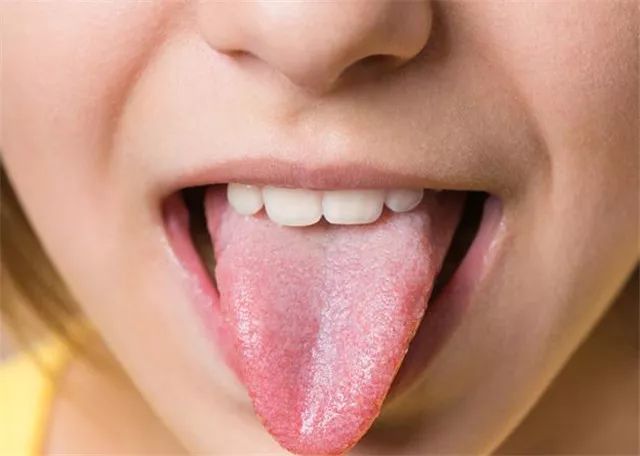
1. Normal Tongue Appearance

Normal Tongue Appearance: The tongue is soft, flexible, light red in color, and covered with a thin, evenly distributed, moderately moist white coating, often described as “light red tongue with thin white coating”.
Observing the tongue mainly involves examining the changes in tongue quality and coating. The tongue quality, also known as the tongue body, refers to the muscular and vascular tissue of the tongue.
The tongue coating is a layer of coating attached to the tongue body, which is generated by stomach qi.
The so-called “stomach generates qi” refers to the healthy transformation of the spleen, with the stomach being responsible for receiving (indicating normal digestive function). When the physiological functions of the spleen and stomach are normal, a thin and moist tongue coating can be observed on the tongue. During pathological changes in the body, the fluctuations of yin and yang, the harmony of qi and blood, and the existence of body fluids can all be directly reflected in the changes of the tongue coating. By observing the changes in the tongue coating, one can understand the condition of the internal organs (visceral organ changes) and the severity of diseases.
2. Cracked Tongue
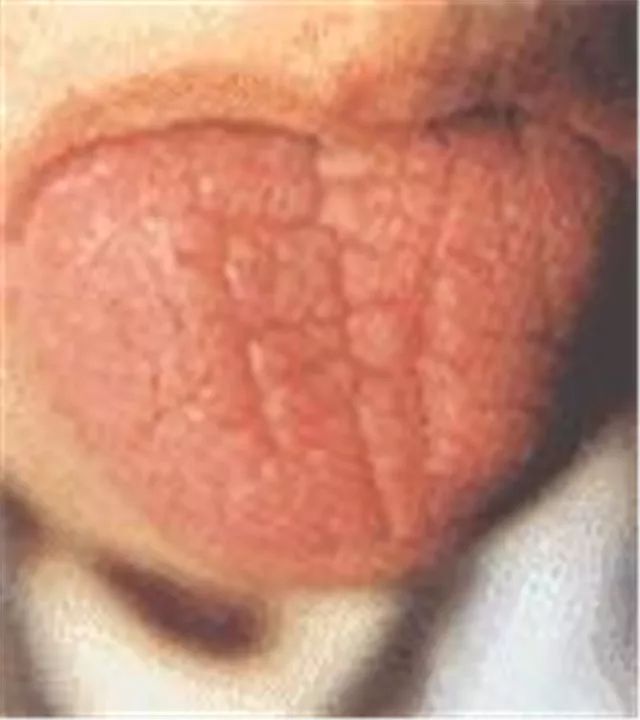
Illustration: Cracked Tongue: The tongue surface shows various cracks of different depths and shapes, referred to as cracked tongue.
Cracked tongue indicates: (1) Excess heat injuring yin, often seen as a red tongue with cracks; (2) Blood deficiency leading to lack of moisture, often seen as a pale tongue with cracks; (3) Spleen deficiency with dampness, often presenting as a pale, plump tongue with teeth marks and cracks. Treatment should focus on nourishing yin essence, benefiting qi, and generating fluids; tonifying the spleen and draining dampness; nourishing yin and clearing heat; and relieving dryness.
Additionally, cracked tongue refers to cracks in the tongue body and also in the tongue coating; during diagnosis, one should differentiate based on the dryness or moisture of the coating. If the cracks are due to dryness, it indicates an external disease with heat injuring fluids, leading to severe dryness. If the coating has moisture and cracks, it is often due to qi deficiency.
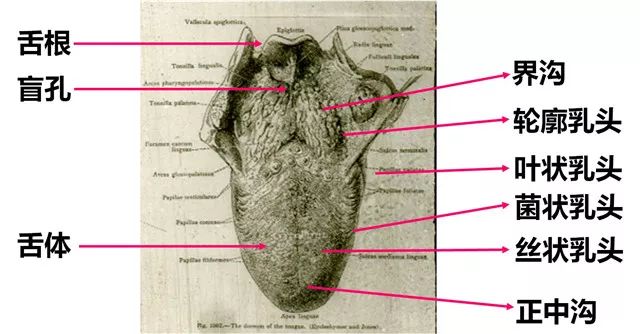
3. Enlarged Tongue

Illustration: Enlarged Tongue: The tongue body appears swollen and enlarged, or has teeth marks on the edges, and is pale and tender.
Associated Conditions and Research:
Enlarged tongue has also been discussed in ancient texts in relation to swollen tongue. In fact, an enlarged tongue is caused by deficiency of spleen yang qi, or combined with cold dampness, leading to a swollen, tender, pale tongue, often with teeth marks, which is a sign of deficiency and should be distinguished from a swollen tongue.
4. Teeth-marked Tongue
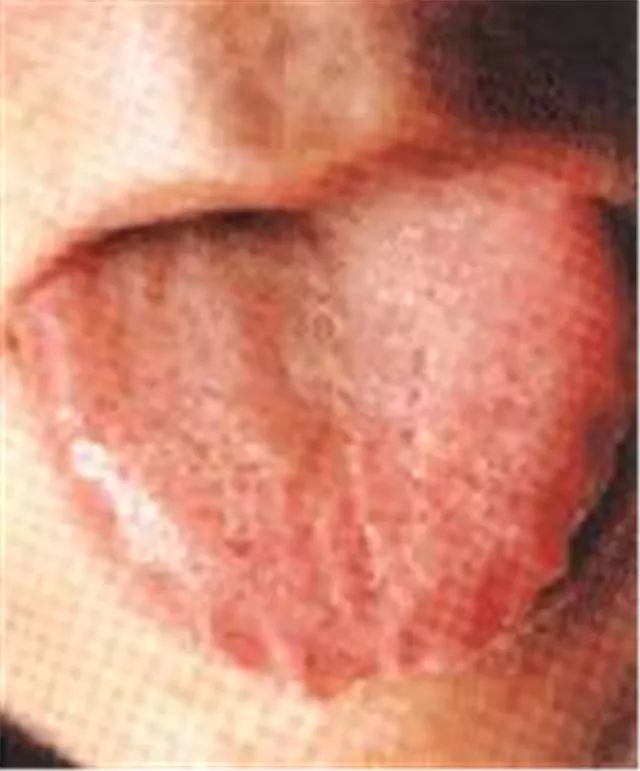
Illustration: Teeth-marked Tongue: The edges of the tongue show impressions from the teeth, indicating a teeth-marked tongue.
Teeth-marked tongue is often caused by the tongue body being enlarged and pressed by the teeth, thus it is often seen together with an enlarged tongue, mostly indicating spleen deficiency and a deficiency syndrome.
If the tongue quality is pale and moist, it indicates spleen deficiency with cold dampness accumulation.
The cause of teeth-marked tongue is often due to spleen deficiency failing to transform and transport fluids, leading to dampness obstructing the tongue and causing it to enlarge, which is then pressed by the teeth, resulting in the marks. Therefore, teeth-marked tongue is often seen with a plump tongue, on one hand due to tongue edema, indicating spleen yang deficiency and dampness accumulation, and on the other hand due to relaxation of the tongue muscles, insufficient opening of the mouth, indicating spleen qi deficiency.
5. Thin White Coating
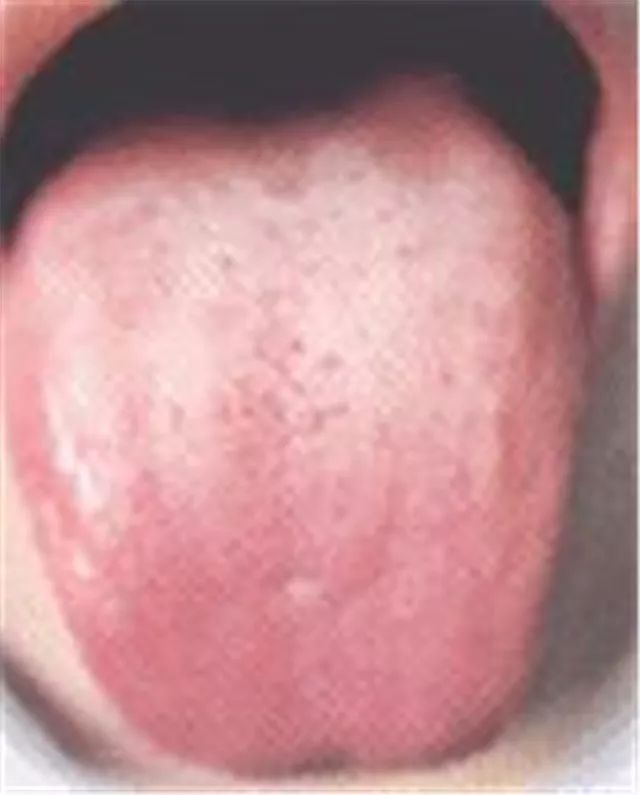
Illustration: Thin White Coating: The coating is thin and evenly distributed on the tongue surface, with moderate moisture.
Associated Conditions and Research:
Thin white coating, with a light red and moist tongue, is the most common tongue coating under normal conditions, indicating “stomach generates qi”.
The formation of thin white coating is mainly due to the combined effects of chewing, swallowing, saliva, and diet, which continuously remove and shed substances between the filiform papillae of the tongue mucosa, resulting in only a thin white layer of coating.
6. Dry Thin White Coating

Illustration: Dry Thin White Coating: The white coating is thin on the tongue surface, with less fluid and a tendency to be dry.
Associated Conditions and Research:
Dry thin white coating is due to damage to lung fluids and qi, where qi deficiency leads to insufficient fluid transformation, and less fluid results in dryness of the coating.
Commonly seen in wind-heat invading the lungs, where pathogenic qi injures the lungs, or due to yang deficiency failing to transform fluids, leading to insufficient moisture in the lungs; the former should clear and moisten, using Yin Qiao San to nourish yin, clear heat, and generate fluids; while the latter should benefit qi and generate fluids, using methods like Xuan Fei Yi Qi Tang to raise yang and benefit qi.
7. Thick White Greasy Coating
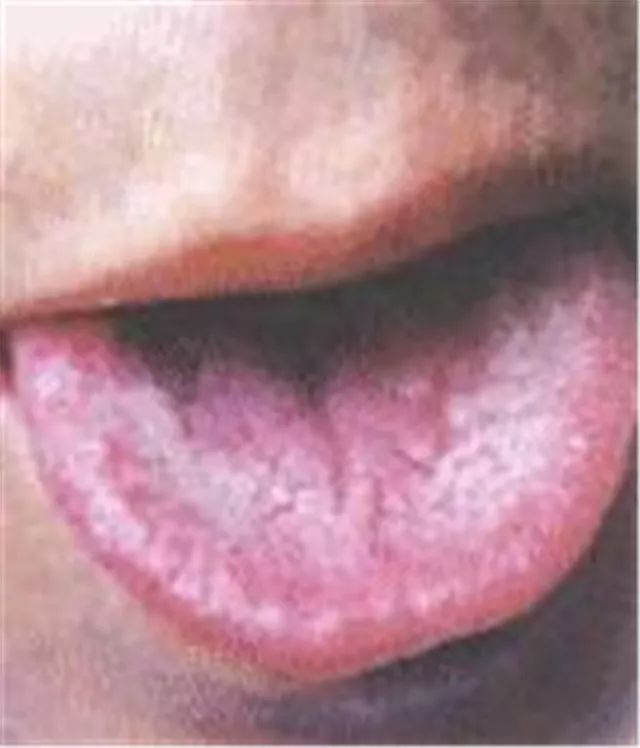
Illustration: Thick White Greasy Coating: The tongue coating is white and thick, with tightly packed or loose granules, which can cover the entire tongue or be thinner at the edges.
Associated Conditions and Research:
Thick white greasy coating is often due to insufficient yang qi in the middle burner, leading to food stagnation, or dampness and phlegm accumulation.
According to the “Tongue Diagnosis Guide”: “White greasy coating, chest oppression and pain, irritability and dry vomiting; often wanting to drink water, but vomiting upon intake, indicates heat due to drinking stagnation, should use pungent and light methods to transform the drink.”
Thick white greasy coating indicates: dampness, phlegm, and cold.
8. White Coating with Dry Cracks

Illustration: White Coating with Dry Cracks: The coating is white, can be thin or thick, with rough and loose granules, dry and hard, resembling sand or stone, and if the granules are finer and hard, with transverse and longitudinal cracks, it is referred to as white coating with dry cracks.
Associated Conditions and Research:
White coating and dry cracks can appear simultaneously on the tongue surface, hence collectively referred to as white coating with dry cracks.
This is mainly due to internal heat suddenly arising, causing rapid damage to fluids. It is often seen in acute febrile diseases, where sudden heat injures fluids, and true yin is about to deplete, while the coating has not yet turned yellow; if the coating is white and cracked but not too dry, it is often seen in summer heat, where summer heat injures qi, with internal dampness and turbidity.
9. Yellow Greasy Coating
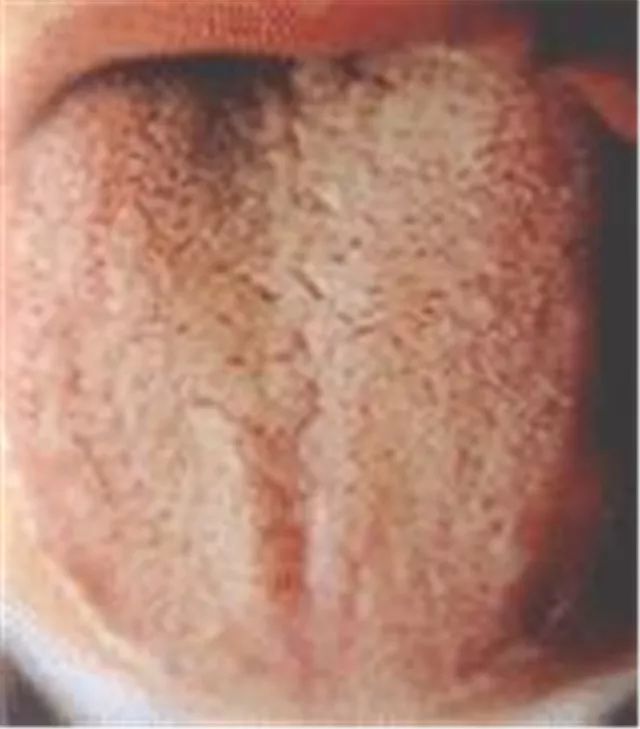
Illustration: Yellow Greasy Coating: The tongue coating is yellow and greasy, with tightly packed granules, and a yellow powdery substance applied to the tongue surface.
Associated Conditions and Research:
Yellow greasy coating is formed by the combination of pathogenic heat and phlegm-dampness. Yellow coating indicates heat, while greasy coating indicates dampness, phlegm, or food stagnation.
Yellow greasy coating indicates: damp-heat accumulation, phlegm-heat transformation, or food stagnation transforming into heat; it also indicates external heat invasion, damp-heat, etc. Treatment should focus on clearing heat, transforming dampness, and eliminating phlegm.
Additionally, when diagnosing yellow greasy coating, one should also consider the quality of the tongue.
10. Yellow Dry Coating
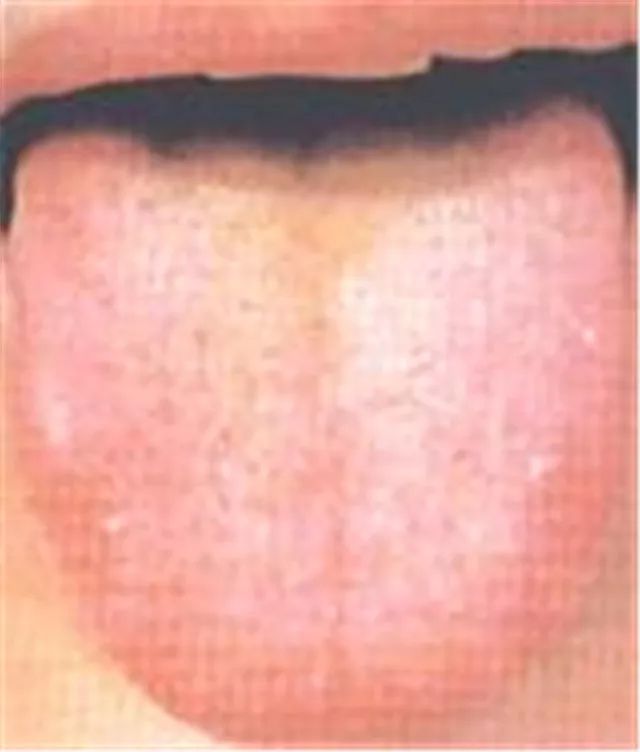
Illustration: Yellow Dry Coating: The tongue coating is yellow, dry, and has little fluid (liquid), indicating a pathological change due to heat injuring fluids.
Associated Conditions and Research:
Yellow dry coating indicates: pathogenic heat penetrating internally, treatment should focus on directly purging heat and clearing the interior. When heat is excessive in the qi level, leading to fluid damage, it is advisable to use pungent and cold methods to clear heat and protect fluids. In cases of excess heat in the interior, where pathogenic heat accumulates in the viscera, it is advisable to use bitter and cold methods to purge and relieve heat. When heat recedes and fluids are damaged, treatment should focus on sweet and cold methods to generate fluids. Since yellow dry coating often combines with complex primary diseases, medication should also be determined based on the condition.
11. Yellow Coating
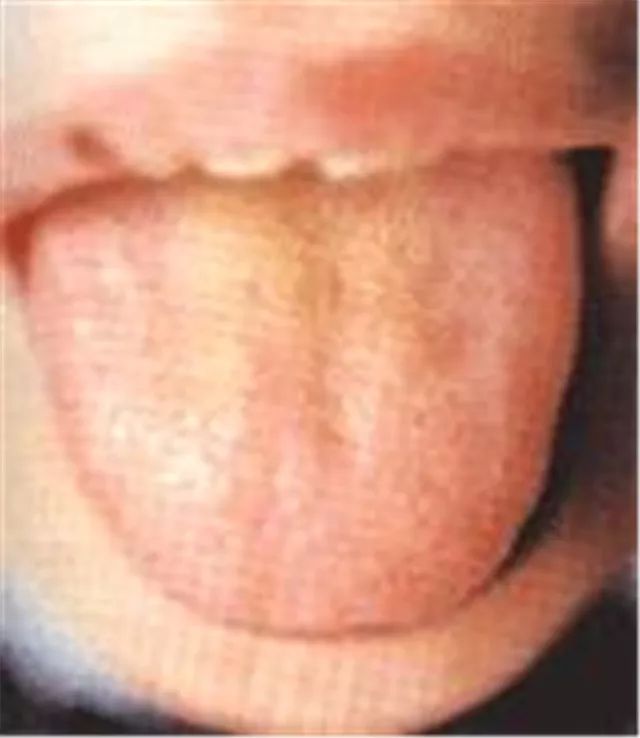
Illustration: Yellow Coating is a common pathological tongue coating, which can also be seen in some healthy individuals.
Yellow coating seen in healthy individuals is mainly thin yellow coating and thin yellow greasy coating. Thick yellow greasy coating tends to increase with age.
Yellow coating indicates: spleen and stomach diseases, interior syndromes, and heat syndromes. The “Comprehensive Guide to Tongue Diagnosis” states that yellow coating can be present in both excess heat syndromes and deficiency cold syndromes, but not in deficiency cold syndromes. Pathogenic heat scorches and burns, leading to yellow coating; light yellow indicates mild heat; deep yellow indicates severe heat; burnt yellow indicates heat accumulation. In external diseases, the transition of tongue coating from white to yellow indicates that the exterior pathogen has entered the interior and transformed into heat; in typhoid fever, it belongs to the yangming level; in warm diseases, it belongs to the qi level.
However, yellow coating can also be seen in exterior syndromes and deficiency cold syndromes: if thin white with light yellow coating is present, it indicates wind-heat exterior syndrome or wind-cold transforming into heat; if light yellow thick coating is present, it indicates chest damp-heat, qi stagnation; if the tongue is plump and tender with yellow slippery coating, it indicates yang deficiency with water accumulation transforming downwards. Therefore, yellow coating indicates interior conditions but is not absolute.
12. Thin Yellow Coating

Illustration: The tongue coating appears yellow, with thin yellow coating that is light yellow.
Associated Conditions and Research:
Thin yellow coating is a common pathological tongue coating, which can also be seen in some healthy individuals. Common yellow coating is mainly thin yellow coating and thin yellow greasy coating. Thick yellow greasy coating tends to increase with age.
Thin yellow coating often develops from white coating, indicating that the pathological change has transformed from cold (cold from the six excesses) to heat, moving from the exterior to the interior (indicating worsening condition or prolonged illness).
13. Gray Coating
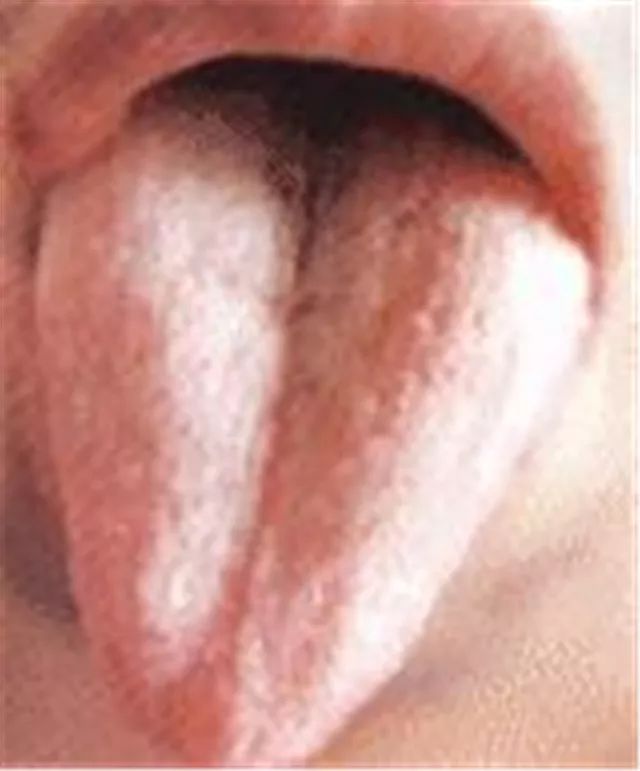
Illustration: Gray Coating: The tongue coating appears gray with black tones, referred to as “gray-black tongue coating”.
Associated Conditions and Research:
Gray coating indicates: dryness, often associated with yangming organ excess, where yin fluids have been damaged. If the coating is dry, it indicates excess heat in the yangming organ; if there is no excess heat, with a fine and rapid pulse, treatment should focus on bitter and cold methods to rescue fluids.
If gray coating is greasy, it indicates phlegm-dampness obstructing internally, often seen in warm diseases combined with phlegm-dampness, or accompanied by other severe symptoms, requiring careful differentiation.
Treatment should focus on warming the middle, drying dampness, and using aromatic methods to clear. If gray coating is slippery and moist, with a fine pulse, it indicates yang deficiency with cold symptoms, requiring warming yang and dispelling cold, such as using Si Ni San or Li Zhong Wan.
Additionally, gray coating indicates various conditions of cold, heat, and dampness, and clinical diagnosis should also consider tongue quality, moisture, and other symptoms.
14. Burnt Yellow Coating
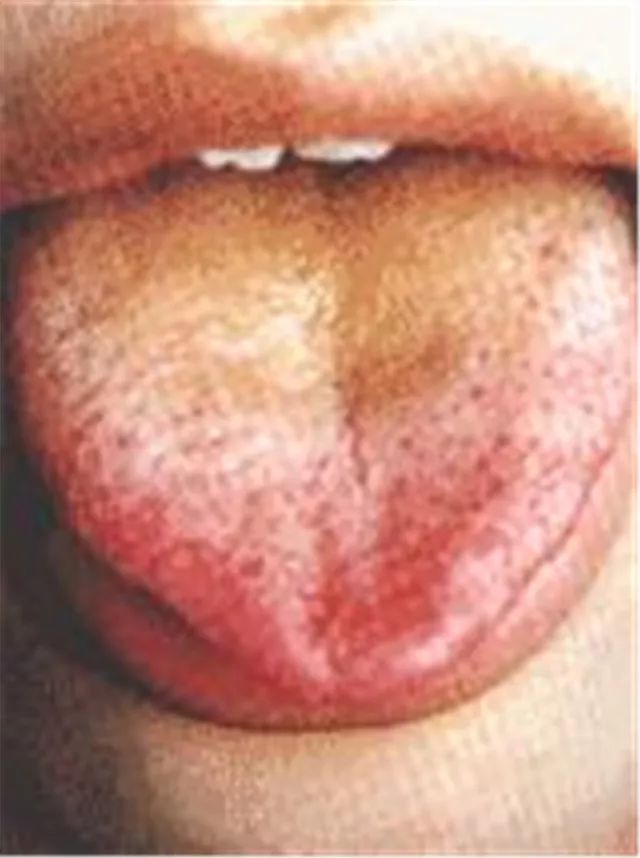
Illustration: Burnt Yellow Coating: The tongue coating appears old yellow and burnt, or thick and deep yellow, especially in the center or at the root of the tongue.
Associated Conditions and Research:
Burnt yellow coating indicates internal heat accumulation in the stomach. According to the “Tongue Diagnosis in Traditional Chinese Medicine”: “Yellow and dry indicates damage to stomach fluids; old yellow and burnt indicates severe heat; old yellow and black indicates extreme heat resembling water; urgent treatment is required; yellow and dry with sharp edges, or foul-smelling water indicates intestinal decay.”
15. Pale White Tongue with Little Fluid
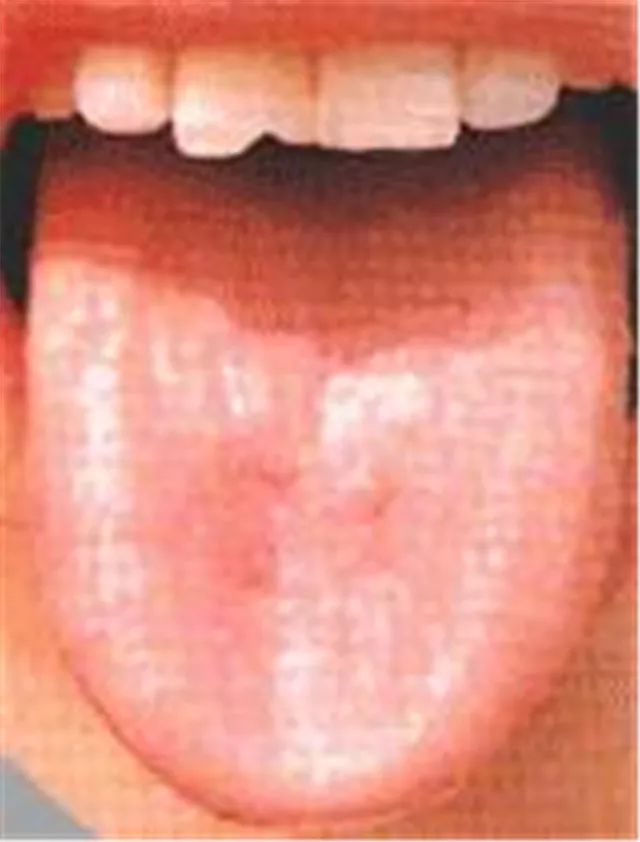
Illustration: The tongue has insufficient fluid, or even no fluid.
Associated Conditions and Research:
Pale white tongue with little fluid is often due to deficiency of yang qi, which fails to generate and transform fluids, or yang deficiency leading to water stagnation, resulting in insufficient distribution of fluids to the tongue.
The tongue appears pale white with little fluid, as fluids are transformed from food essence through the warming action of yang qi, and then distributed throughout the body by yang qi. If the yang qi of the middle and upper burners (spleen and lungs) is weak, the spleen yang cannot generate fluids, and the lung qi cannot distribute fluids.
For patients with water stagnation in the abdomen, the mouth and tongue may appear dry, indicating a syndrome. Yang deficiency fails to transform water into fluids, nourishing the orifices, and fails to distribute fluids, leading to a pale white tongue with little fluid.
Pale white tongue with little fluid indicates: yang qi deficiency, insufficient fluids. Treatment should focus on tonifying yang, benefiting qi, and generating fluids to relieve dryness.
16. Pale White Tongue with Stasis

Illustration: The tongue coating is thin white, with a pale white tongue showing stasis spots.
Associated Conditions and Research:
Pale white tongue with stasis: Previous literature has rarely discussed pale white tongue with stasis (spots, dots), but clinically, this tongue appearance does exist. Analyzing its formation, it is often related to blood deficiency combined with stasis. Modern microcirculation studies of the tongue have found that pale white tongue indicates insufficient filling of microvessels within the filiform papillae.
Moreover, slow blood flow and narrowed vessel diameter lead to local blood stasis, causing red blood cells to aggregate, resulting in pale white tongue with stasis spots or dots on the edges and tip.
Indications: qi deficiency with blood stasis. Blood deficiency and blood stasis.
17. Pale White Glossy Tongue
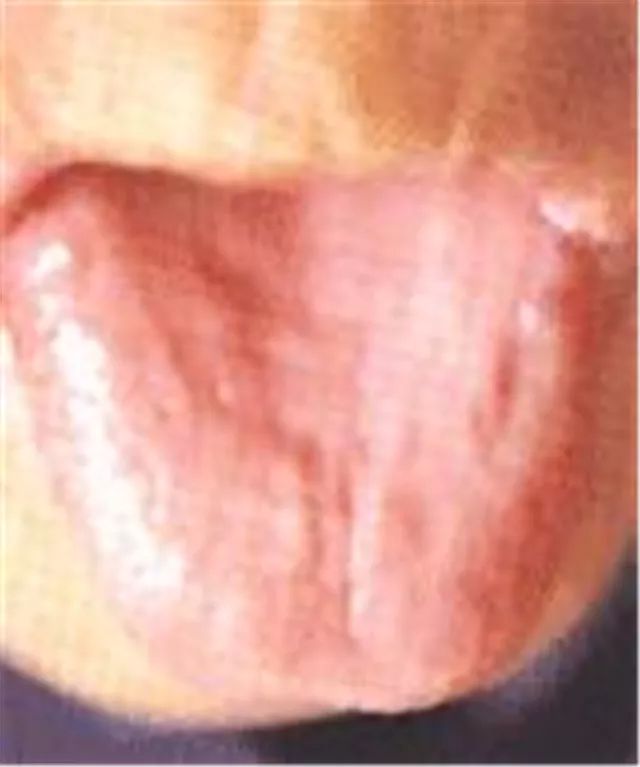
Illustration: The tongue appears pale white, with all the coating shed, smooth like a mirror, resembling freshly peeled chicken skin.
Pale white glossy tongue is due to damage to the spleen and stomach, with both qi and blood deficiency, leading to prolonged malnutrition, causing the tongue quality to lack sufficient nourishment, resulting in gradual shedding of the tongue coating without new coating growth, leading to a completely pale white and glossy tongue.
Additionally, one should differentiate pale white glossy tongue from pure white tongue and pale white transparent tongue.
18. Pale White Moist Tongue
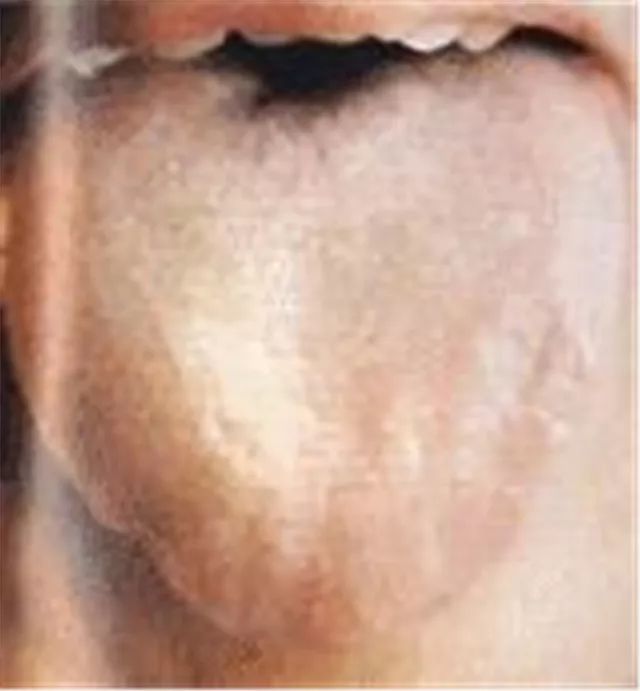
Illustration: Pale White Moist Tongue: The tongue appears pale white, moist, or with abundant fluids.
Associated Conditions and Research:
The former pale white tongue indicates qi and blood deficiency, with a tongue body that is normal or slightly small. Qi deficiency fails to generate blood, or blood deficiency leads to qi deficiency, ultimately resulting in both qi and blood deficiency.
This condition fails to nourish the tongue surface, often due to prolonged illness or excessive blood loss. Treatment should focus on tonifying both qi and blood, using formulas like Shi Quan Da Bu Tang to gradually achieve results.
The latter moist tongue indicates spleen deficiency with cold dampness, where the tongue body is plump and tender, with teeth marks on the edges, often due to spleen yang deficiency, leading to insufficient transformation of fluids, causing dampness to accumulate on the tongue, resulting in a moist and plump tongue. Treatment should focus on warming the spleen, assisting yang, and dispelling cold dampness.
19. Bright Red Cracked Tongue
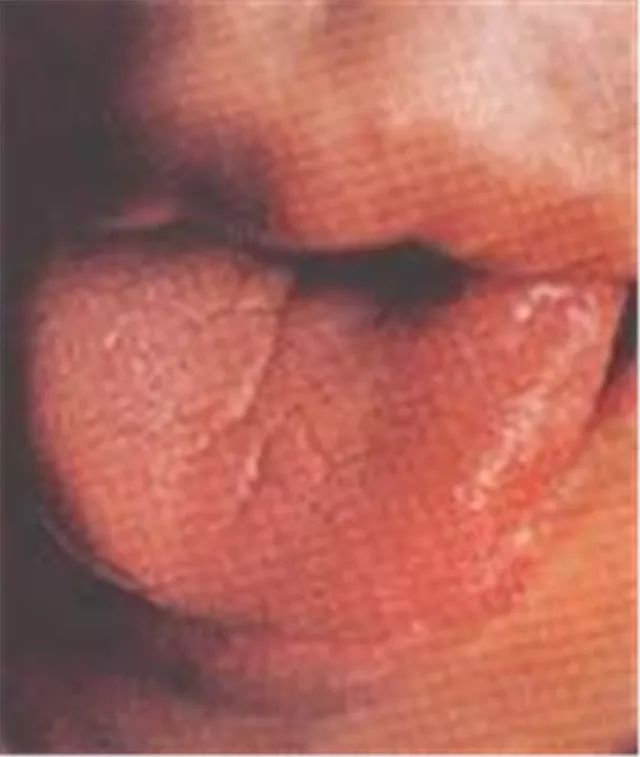
Illustration: The tongue appears bright red, with cracks resembling a human character or other shapes.
Associated Conditions and Research:
Bright red cracked tongue indicates heart fire blazing and heat toxins steaming; if the tongue is deep red with uneven white coating or no coating, and has many cracks resembling deep grooves, it often indicates excessive fire and insufficient yin, or true yin depletion. If the cracks resemble the characters “人” or “川”, or are straight grooves, it indicates excessive heat injuring fluids, burning stomach fluids, or kidney water attacking the heart.
Bright red cracked tongue indicates: yin deficiency with heat, pathogenic factors entering the blood and nutrients, insufficient stomach yin, and phlegm-heat accumulation. Treatment should focus on clearing the heart, draining heat, nourishing yin, and generating fluids.
20. Bright Red Tongue with White Spots
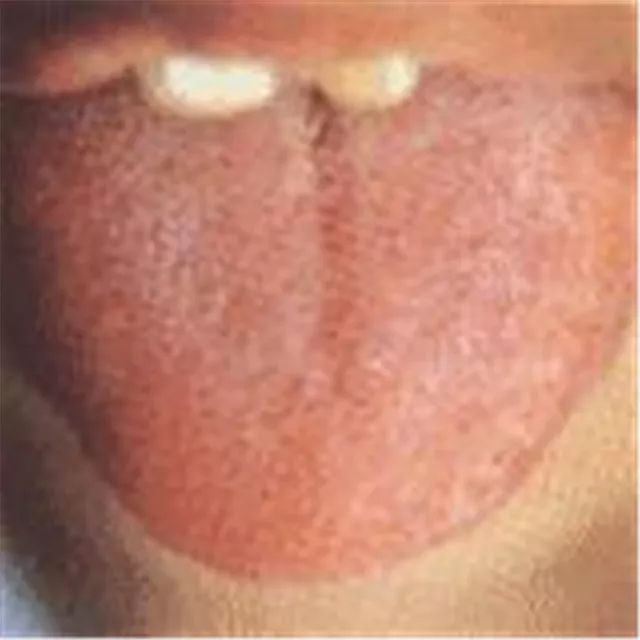
Illustration: The tongue appears bright red, with scattered white spots on the surface, raised above the tongue surface, indicating severe heat toxins, and a sign of impending ulceration.
Associated Conditions and Research:
Bright red tongue with white spots is due to spleen and stomach qi deficiency, unable to withstand the attack of heat toxins.
Bright red tongue with white spots indicates: severe heat, spleen and stomach qi deficiency leading to heat toxins attacking; treatment should focus on clearing heat, dispelling toxins, and nourishing the stomach while clearing heat.
21. Old Tongue
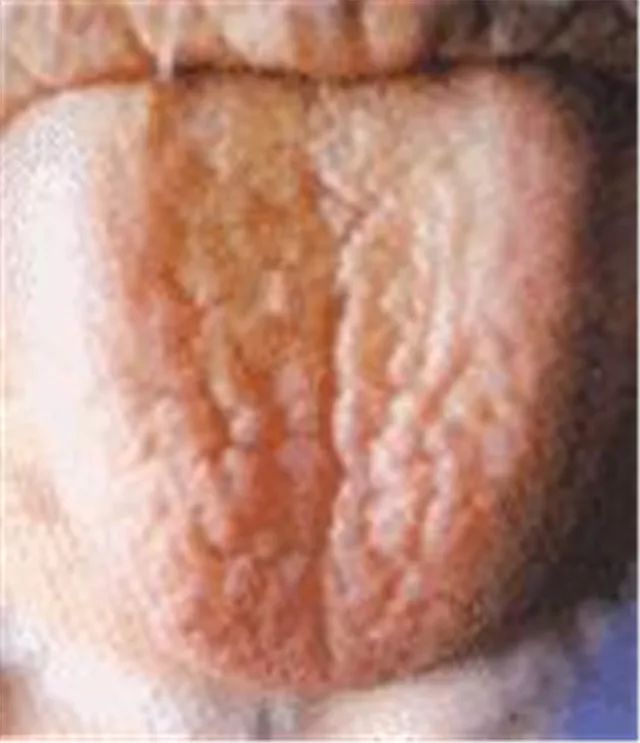
Old tongue often indicates that pathogenic factors are strong while righteous qi is weak, resulting in a firm texture and a pale color.
The “Clinical Tongue Examination Method” states that for any object, if it is firm, it indicates excess; if it is soft, it indicates deficiency.
Moreover, if the qi is still young, the texture is still tender, and the qi is abundant, the texture will be firm.
Therefore, regardless of tongue color or coating, a pale and old tongue indicates an excess syndrome.
Additionally, excessive pathogenic heat and qi and blood stagnation lead to a firm and retracted tongue, indicating a strong conflict between righteous and pathogenic factors, often indicating an excess heat syndrome.
22. Bright Red Dry Tongue
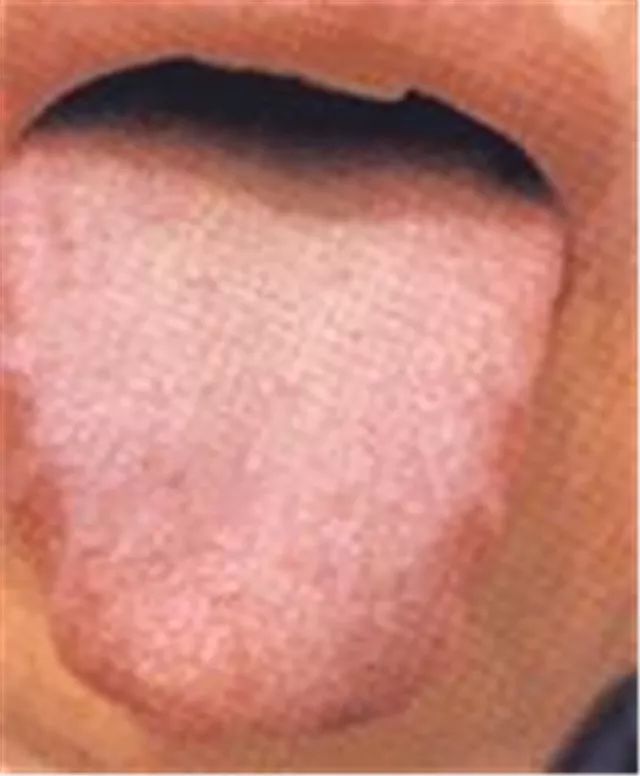
Associated Conditions and Research:
According to the “Tongue Diagnosis and Differentiation”: “A tongue that is bright red and lacks moisture, with the entire tongue appearing bright red, soft and tender but without moisture, looks moist but is actually dry and dehydrated, indicates yin deficiency with excessive fire.”
In external diseases, when heat pathogens enter the interior, the nutrients and fluids are damaged, this tongue appearance can be observed.
It may also occur in internal injuries, where the body constitution is deficient in yin, with prolonged illness leading to deficiency of both qi and blood, resulting in insufficient distribution of fluids, causing the tongue to appear bright red and dry.
If only the tip of the tongue is bright red and dry, while the rest is light red, it indicates a strong heart fire.
 This article contains no advertisements or rumors. Long press the QR code and follow us to see more health knowledge. Every share can help more relatives and friends.
This article contains no advertisements or rumors. Long press the QR code and follow us to see more health knowledge. Every share can help more relatives and friends.

